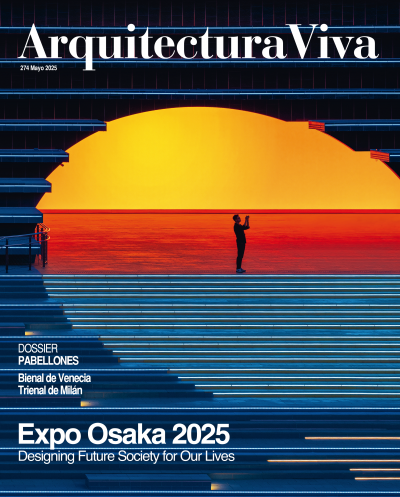

Each panel is really a sandwich composed of two flat surfaces of four layers each, held up by an inner metal substructure onto which they are simply screwed to facilitate future dismantling and reuse...
From the roof’s intricate structure to the signage, the building is based on the geometrical patterns of a technique of scratching plaster – ganch carving – used in Central Asia to decorate palaces and temples...
A work of AMO, the exhibition design offers a journey through twelve locations along the Qatari coast, around a cinema lined with curtains that are an abstract recreation of the experience of taking shelter in a tent...
Almost 3,000 pieces of solid wood are joined by means of a sophisticated system that combines traditional Japanese carpentry with the naval know-how of the island in the Persian Gulf. Like the hull of a dhow – a type of boat of Arabian origin – the s
The snail-like geometry of the design allows a progression in the visitor’s experience of the interior, where a fluid public space culminates in an introspective concert hall located at the heart of the pavilion...
The cluttered mesh of streets characteristic of Arabian cities has been reproduced by means of a computer model in order to optimize bioclimatic protection...
While the central space for events is lit by a round skylight overhead, integrated into the passable roof, the uninterrupted gallery provides large surfaces for the display of Bohemian glass art...
The timber used in the structure of portal frames came from cypress forests in the vicinity, treated with a kind of tar that mixes persimmon pulp with pine charcoal to protect the material and give it a distinctive grayish tone...
In front of an auxiliary block clad in wood is a cluster of globes formed by two-layered thermoplastic pillows, which are inflated to ensure normal pressure inside and avoid the need for airlocks...
The dome-like hall is enclosed with a skin of undulating metal louvers, which together cover exactly 425 meters, in commemoration of the 425 years of trade relations between the Netherlands and Japan...
Like a grand opéra, the exhibition is divided into acts: the ceremonious entrance is followed by a sequence of thematic spaces that look over the ground floor, to which one returns after an interlude in the rear garden...
From the porticoed structure of red cedarwood to the colored ceramic pieces of the facade and interior finishes, all the materials are integrated into a circular system, collapsible and reusable. Like a dive into deep waters, a visitor ramp clad in d
The project begins with the exploration of towns and cities of Saudi Arabia, and plays with scale, light, and texture to showcase the country’s culture. The organic forms of traditional Saudi villages are evoked. Visitors enter from an esplanade wit
The base is designed with prefabricated modules which transport the rest of the material, and which are assembled with three cranes that become part of the pavilion. A large fabric is stretched out over the more than thirty inflatable spheres that fo
To simplify and lighten the construction of the pavilion, its design takes as reference the apparent formal simplicity of old wooden ships, while the layout of the interior spaces is inspired by the constellation of Aquarius...
The proposal stands out for its organic forms and its contact with the natural environment, establishing at the same time a connection with the sea world. The project includes several aquatic elements built using sustainable materials...
The geometry which configures the spaces is directly related to the evocation of the aquatic world: the layout of undulating surfaces can suggest water landscapes for some or wandering among boat hulls for others...
Besides an easterly route from the Philippines to Acapulco, the Augustinian friar Andrés de Urdaneta discovered a north-flowing current towards the Japan Sea. Both phenomena helped Spain create an enriching commercial and cultural channel in the Paci
Photographs by William Mulvihill offer a walk through the Spanish Pavilion at the 2025 World Expo in Osaka, open until 13 October on the artificial island of Yumeshima. A ring-shaped avenue paved in wood, designed by Sou Fujimoto, surrounds the premi
Visitable until 13 October is the World Expo of Osaka, the Japanese city’s second. If in 1970 the future envisioned was one of steel and concrete, this time the fair is a sampling of sustainable construction that will leave no built legacy: the premi
Cut off from the world for three centuries, the Japan of the Edo period had to compensate for its prohibition of trade through ingenuity, and the scarcity of wood, cotton, and other goods gave rise to a solid culture of recycling that precluded any f
The Island and the Ring Inaugurated last 13 April, the World Expo of 2025 is being held on the artificial island of Yumeshima, ‘Island of Dreams,’ a tract reclaimed from the sea on Osaka Bay that until recently was an infrastructural void, one which
The Universal Exposition of 2025 has opened in Osaka, to run through 13 October. This is Osaka’s second hosting of the event, after Expo ’70, and the theme this time is ‘Designing Future Society for Our Lives.’ A work of Sou Fujimoto, a huge wooden s

